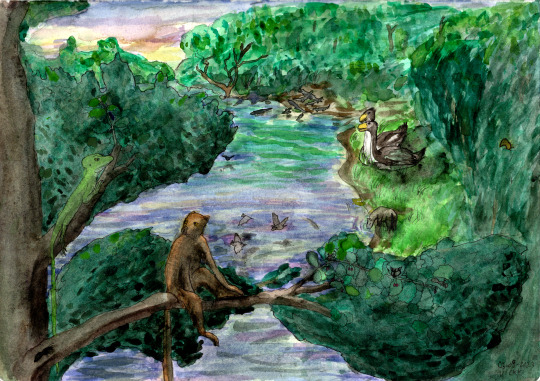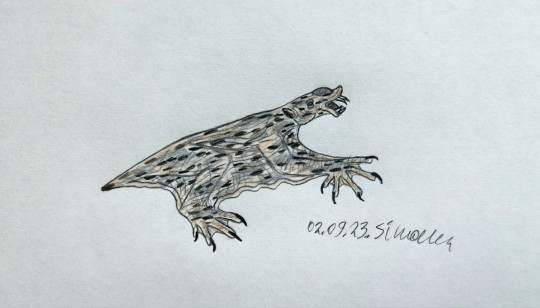#adapiform
Explore tagged Tumblr posts
Text

On a lovely evening 47 million years ago, Darwinius and Geiseltaliellus are forced to share their favourite lakeside tree. They do not particularly enjoy each other's company, but are unlikely to do something about it. Their tree has also become the grave of a couple of Titanomyrna infected with a cordycipitoid fungus, the giant ants spreading the fungus in their death grips. Meanwhile, a pair of Gastornis enjoys the evening Sun while a Eurohippus takes a drink, safe in the knowledge that these giant birds are herbivores. Archaeonycteris hunt insects above the lake, while various crocodylians hang out and get ready for the night.
#darwinius#geiseltaliellus#gastornis#eurohippus#titanomyrna#cordyceps#archaeonycteris#eocene#paleogene#paleoart#palaeoblr#my art#kopidodon#messel pit#adapiform#primate#mammal#corytophanid#lizard#squamate#bird#equid#perissodactyl#ant#insect#cw: bugs#cw: parasites#bat#crocodylian#i think that's everyone
59 notes
·
View notes
Text
youtube
When Was The Most Dangerous Time To Be Alive? | History of Humankind
#natural history#prehistoric life#prehistoric#prehistoric mammal#mammals#pliestocene#oligoacene#ice age#ice ages#human evolution#early primate#primates#fossil record#prehistoric ape#adapiformes#prehistoric animals#paleontology#survival#climate change#Youtube
0 notes
Text

Unlike their larger cousins, the yellow lorodo is built for speed. A thin frame and extended system of air sacs makes them a nimble predator capable of reaching a sustained run of 50 MPH for miles, allowing them to run down their preferred giraffoid and adapiform prey
36 notes
·
View notes
Text

Blooderma
A parasitic adapiform found mainly on sauropods. They use their hooked claws to stay still and their sweat is sticky , which helps to not fall from it's host. Smell of sweat often also mimics natural smell of it's host , helping to hide. Bloodermas also have a tendency to kill other parasites not of their kind , to reduce competition.
Spectember day 9: Parasitic mammal

8 notes
·
View notes
Text

†Notharctus tenebrosus
Art credit: WillemSvdMerwe
Some of the earliest primates were the Adapiformes, which emerged in the Eocene period more than 50 million years ago. Notharctus was one of these very early primates. It lived in and around what is now Utah, USA, which may seem like an odd place for a primate to be- until you consider that at the time it lived, the Earth was much warmer and wetter, with no permanent polar ice caps, and lush, warm forest would have covered much of what is now dry grassland and snowy boreal forest.
#markhors-menagerie#animal facts#fun facts#animals#biology#basal primates#primates#prehistoric animals#prehistoric life#palaeontology#notharctus
18 notes
·
View notes
Text
Round 1, part 1, match 1: super basal primates
†Notharctus (Notharctus tenebrosus)

Artwork credit: WillemSvdMerwe
Some of the earliest primates were the Adapiformes, which emerged in the Eocene period more than 50 million years ago. Notharctus was one of these very early primates. It lived in and around what is now Utah, USA, which may seem like an odd place for a primate to be- until you consider that at the time it lived, the Earth was much warmer and wetter, with no permanent polar ice caps, and lush, warm forest would have covered much of what is now dry grassland and snowy boreal forest.
Calabar angwantibo (Arctocebus calabarensis)

This relative of the pottos and lorises lives in the tropical rainforest of Western Africa. It eats insects, usually caterpillars, as well as some occasional vegetation. It is also slow-moving and nocturnal- the angwantibo and its relatives are unusual primates in many ways, more like nocturnal sloths than monkeys. The calabar angwantibo also has a nictitating membrane, because… why the hell not?
11 notes
·
View notes
Note
hi! what do you think treelings look like :)
well it’s kind of hard to say, i mean the author makes them sound 100% like ring-tailed lemurs (and that’s how they’re depicted on the book cover), but those are only native to Madagascar and the Named series takes place in California

Since lemurs don’t exist in North America, the closest we can get is through the group Adapiformes, which died out during the Miocene (unfortunately there’s not a ton of info on them, but they’re not true lemurs). My closest guess to actual species would be something similar to Notharctus

129 notes
·
View notes
Text

Notharctus Tenebrosus - by WillemSvdMerwe
Another very ancient human/ape/monkey/lemur ancestor! This is Notharctus tenebrosus, the 'gloomy false bear'. What an inappropriate scientific name! It was likely a bright and lively critter. Living in the early Eocene, about 40-50 million years ago, in Wyoming (and likely much of the rest of North America), which back then had a warm climate and lush forests. Its first fossils were very fragmentary and were considered to belong to a 'pachyderm' (a term with no clear meaning classification-wise, other than including elephants and rhinos). But soon after, much better fossils showed what it really was. It was an Adapiform, a group close to the mutual ancestry of lemurs, monkeys, apes, humans ... pretty much all living primates. But they were likely closer to our modern lemurs, bushbabies, lorises and pottos ... that is to say, already on the strepsirrhine branch of the tree, while the other branch, the haplorhines, was already separated and evolving into the ancestors of humans, apes and monkeys. But at the time they all would have looked very similar and lemur-like. Notharctus was likely a leaf-eater. As always, I'm using my imagination in supplying it with a coat pattern and colour scheme. It was likely bright and bold, since it was day-active and all primates have good colour vision and put store in prominent visual features.
#eocene#natural history#palaeontology#paleoart#prehistoric life#paleontology#prehistoric mammal#prehistoric animals
3 notes
·
View notes